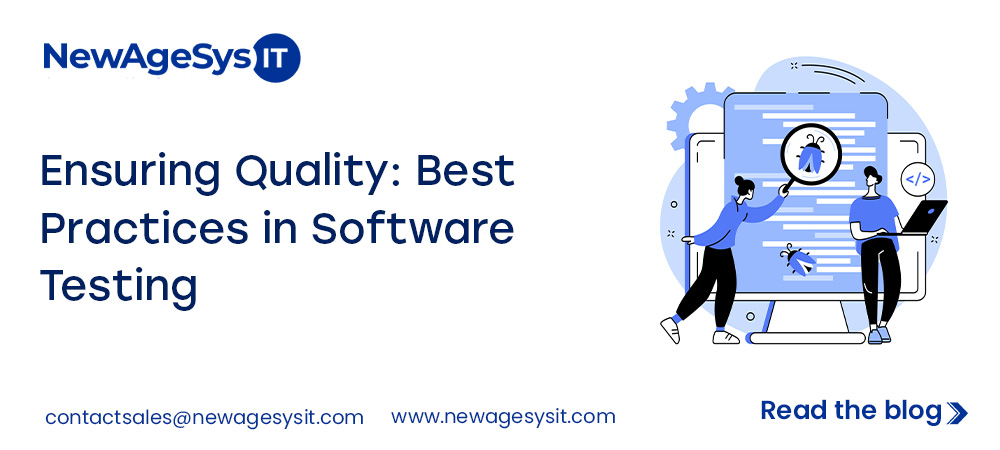In today’s fast-paced tech world, it’s more important than ever to make sure our software is top-notch. And you know what as apps are getting more complex and playing a bigger role in our daily lives, we need to be extra careful about testing them. The best thing is that when following the best practices for software testing, we can make sure our products are reliable, secure, and perform at their best. This results in fewer issues, happier users, and an improved user experience overall. This blog will explore the best practices in software testing and provide examples of how organizations such as NewAgeSysIT may help achieve remarkable software quality.
Understanding Software Testing
To be simple, software testing is a procedure that assesses an application’s stability, performance, and functionality. You just imagine software testing as a detective’s job. And what they do, yes they examine every nook and cranny of a program to find any hidden problems. It’s like quality control for your software, ensuring it meets the needs of your customers. And thus software testing plays an important role in quality assurance by reducing errors, guaranteeing requirement compliance, and producing products that meet or surpass customer expectations.
Key Best Practices in Software Testing
Define Clear Requirements
Understanding and clearly articulating requirements is the cornerstone of a successful software testing process. It is essential to have a clear idea of what the software is supposed to do before beginning any testing step. Work closely with stakeholders to identify and collect specific requirements. This clarity will direct your testing endeavors and guarantee that every facet of the software is assessed in relation to its intended objective.
Create a Robust Test Plan
Systematic testing requires a well-organized test plan. The testing plan, scope, materials, schedule, and deliverables should all be described. The test plan serves as a roadmap, ensuring that each testing technique is consistent with the project’s objectives. Provide details regarding the testing environment, success criteria, and testing kinds (such as functional, performance, and security) that will be used. A thorough test plan guarantees that no important details are missed and aids in efficient resource management.
Put Automated Testing into Practice
One best practice that can greatly improve accuracy and efficiency is automated testing. The testing process can be accelerated and human error can be minimized by using automated tests to carry out repetitive activities fast and consistently. This method works especially well for regression testing, which involves reevaluating functionalities that have already been tested to make sure they hold up in the face of additions or changes. Selenium, JUnit, and TestNG are well-liked options for automated testing tools.
Thorough Test Case Design is Mandatory
Well, just think of test cases as a roadmap for your software’s journey. They guide you through different scenarios, from the best-case scenarios to worst-case scenarios and everything in between. Each test case should include a clear description, expected results, and the steps to execute it. Well-designed test cases help ensure that all functional and non-functional requirements are tested, improving the chances of identifying potential issues before the software reaches the end users. And yes, it’s like a safety net, catching potential problems before they become bigger issues.
Prioritize Testing Efforts
Not all problems are equally serious, just as not all elements of an application are made equal. Putting testing efforts in order of risk and impact for each component is a smart practice that guarantees effective resource use. You should give more focus to high-risk regions, essential features, and areas or parts that can impact the user experience. Furthermore, risk-based testing undoubtedly facilitates efficient resource allocation and prioritizes resolution of the most critical problems.
Incorporate Continuous Integration and Continuous Testing
One thing to increase the software quality is by integrating continuous integration (CI) and continuous testing procedures into your development workflow. Consistent integration (CI) entails pushing code updates into a common repository, where automated tests are conducted to find problems with integration at an early stage. By executing automated tests at every stage of the development cycle, continuous testing enhances continuous integration by guaranteeing that errors are found and fixed quickly. This method aids in preserving the high caliber of the program during the development phase.
Engage in Exploratory Testing
Imagine exploring a new city without a map. You’d wander around, discovering hidden gems and stumbling upon unexpected challenges. That’s similar to exploratory testing. Automated and scripted tests are essential, but exploratory testing enhances the process by enabling testers to apply their intuition and creativity. It’s about using your instincts and creativity to find problems that might be missed by following a strict script.
What stands out is that in exploratory testing, the program is tested without pre-written test cases with an emphasis on unscripted exploration as a means of finding bugs. This procedure is a great way to get important insights into the usability and general quality of the product and assists in identifying problems that automated tests could overlook.
Ensure Cross-Platform and Cross-Device Testing
Well, you know that people use software on everything from smartphones to laptops and even smart TVs. And undoubtedly testing for compatibility across platforms and devices is crucial to guaranteeing that your software operates reliably and efficiently in a variety of settings. Cross-platform and cross-device testing ensures your software works smoothly on all different devices, so everyone has a great experience.
Prioritize security testing
Imagine your software as a house. You wouldn’t leave the doors and windows wide open, right? That’s where security assessments come in. For software to remain secret, integrity, or available, security testing is essential to find flaws. You can find it by doing security assessments, such as vulnerability scanning and penetration testing. By finding and fixing these vulnerabilities, you’re protecting your users’ data and keeping their trust.
Leverage Experienced Testing Partners
Software testing can be made much more successful by collaborating with professional testing companies. Software testing specialists such as NewAgeSysIT can offer significant experience, cutting-edge tools, and techniques to guarantee the best possible quality for your program. With our experience, you can help streamline the testing process, identify critical issues, and deliver a robust and reliable product.
Conclusion
Building amazing software is similar to building a house. You’ll need a strong foundation, a comprehensive plan, and skilled personnel. Similarly to software testing, establishing best practices is critical for providing high-quality software that satisfies user expectations and functions consistently. By adhering to the best practices in software testing, you ensure that your software is built on a solid basis, meets all criteria, and is ready to withstand the test of time. The best part is that working with specialists like NewAgeSysIT can help make the process even smoother. With our guidance, you can create software that not only works well but also delights your users.

























